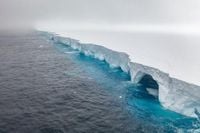In a dramatic turn for the world’s oceans and the science of climate, the largest iceberg ever recorded—known as A23a—has finally begun to break apart after nearly four decades of dominating Antarctic waters. The colossal slab of ice, originally larger than Long Island and twice the size of London, has captured the attention of scientists and the public alike as it rapidly splinters and drifts into warmer seas, signaling both an end of an era and a warning about the planet’s changing climate.
According to CNN, A23a calved from the Filchner-Ronne Ice Shelf in Antarctica back in 1986, setting off on a journey that would see it grounded on the seabed of the Weddell Sea for over 30 years. For decades, the iceberg barely budged, becoming a fixture in the frigid Southern Ocean. But in 2020, the megaberg finally broke free, carried by powerful ocean currents into the so-called "iceberg alley"—the South Atlantic route where many of Antarctica’s icy giants eventually meet their demise.
By early 2025, A23a still covered nearly 3,100 square kilometers (about 1,200 square miles), making it the world’s largest iceberg at the time. For perspective, that’s roughly the size of Rhode Island, and more than twice as large as London. However, the iceberg’s fate was sealed when it drifted north into warmer waters. Satellite images analyzed by the European Union’s Copernicus programme and reported by AFP showed that by September 3, 2025, A23a had shrunk to about 1,770 square kilometers (roughly 656 square miles)—less than half its original size. Some of the fragments that broke away are themselves enormous, with one measuring an astonishing 400 square kilometers. Countless smaller bergs, still large enough to pose hazards to shipping lanes, now litter the surrounding waters.
The breakup has been described as “fairly dramatic” by Andrew Meijers, a physical oceanographer at the British Antarctic Survey, who told AFP, “The grounding and enormous release of cold freshwater are likely to have had a major impact on organisms on the seabed and in the surrounding water.” Meijers added, "It is important to understand these impacts as large icebergs may become a more common feature at South Georgia as a result of global warming.” For a brief period earlier in 2025, A23a even ran aground near South Georgia island, sparking concerns it could block access for millions of penguins and seals returning from the sea to feed their young. Those fears eased when the iceberg dislodged in May and resumed its northward drift, but the release of meltwater continues to affect the local marine ecosystem.
On September 5, 2025, the world’s largest iceberg officially broke apart, as confirmed by multiple satellite monitoring agencies. Just a day later, the Associated Press reported that A23a—once the most enduring and massive iceberg in existence—was splintering rapidly and had lost its title as the largest floating chunk of ice. It is currently drifting between the southern tips of Africa and South America, in the so-called "graveyard" waters where other famous icebergs, like A68, quickly disintegrated.
Scientists say the breakup of A23a is not just a remarkable event in itself, but also a sign of accelerating changes in the Antarctic region. Iceberg calving—the process by which massive pieces of ice break off from glaciers or ice shelves—is a natural part of Antarctica’s cycle. However, as the continent warms faster than the global average, these events are happening more frequently and with greater intensity. According to CNN, “Iceberg calving has accelerated due to climate change,” a view echoed in numerous scientific studies over recent years.
What’s driving this acceleration? As climate change raises global temperatures, the Southern Ocean is warming, weakening the structural integrity of ice shelves and glaciers. When A23a drifted into warmer seas, it was battered by waves and began to dissolve at a much faster rate. “Despite its size and longevity, researchers said the fate of A23a was inevitable once it left Antarctic waters,” reported AFP. Exposed to relentless pounding by the waves and the warming sea, the iceberg’s demise was only a matter of time. Scientists expect it to melt completely into the ocean by as soon as November 2025.
The story of A23a is also intertwined with broader concerns about the effects of glacier retreat. As glaciers recede, they can trigger unexpected consequences, including increased volcanic activity. CNN highlighted recent research showing that when glaciers melt and the pressure on subglacial volcanoes is released, eruptions can become more frequent and explosive. Pablo Moreno-Yaeger from the University of Wisconsin-Madison explained at the Goldschmidt Conference in July 2025, “Glaciers tend to suppress the volume of eruptions from the volcanoes beneath them. But as glaciers retreat due to climate change, our findings suggest these volcanoes go on to erupt more frequently and more explosively.” This phenomenon, while not directly caused by A23a itself, is part of the cascading effects that melting glaciers can have on Earth’s systems.
The environmental impact of A23a’s journey has been significant. The massive iceberg, with its release of cold freshwater and nutrients, can sometimes stimulate marine life in the surrounding seas. However, the presence of such a large obstacle also creates challenges for wildlife, especially when it blocks access to key breeding or feeding grounds. The British Antarctic Survey’s Andrew Meijers emphasized the importance of understanding these impacts, especially as “large icebergs may become a more common feature at South Georgia as a result of global warming.”
While iceberg calving is a natural phenomenon, the increasing frequency and scale of these events are a clear signal that Antarctica is changing—and fast. The rapid breakup of A23a is a stark reminder that even the most enduring natural features are not immune to the forces of climate change. As the world’s largest iceberg dissolves into the sea, scientists are left to study its legacy and what it might mean for the future of the planet’s polar regions.
For now, the saga of A23a closes a chapter in the story of Earth’s ice. Its splintering is both a marvel of nature and a warning sign, underscoring the urgent need to understand and address the broader consequences of a warming world.

